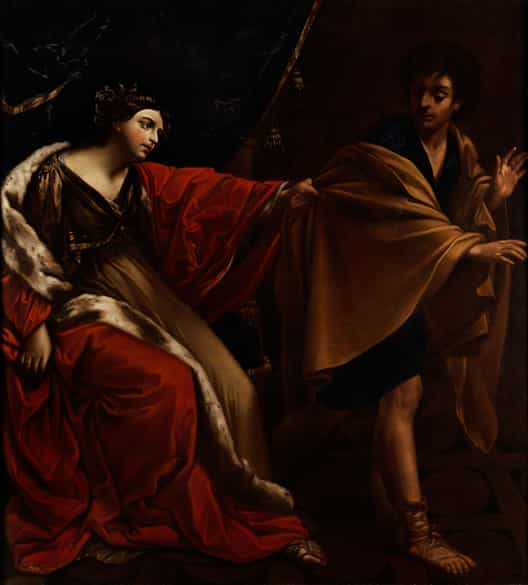Your search for Guido Reni in the auction
16th - 18th century paintings
Thursday, 22 September 2016
» reset
Your personal art agent

You are interested in works by Guido Reni?
We are happy to inform you, if works by Guido Reni are to be auctioned in one of our upcoming auctions.
Please accept our privacy policy
898
Guido Reni,
1575 Bologna – 1642 ebenda
JOSEPH UND POTIPHARS WEIB Öl auf Leinwand.
213 x 190 cm.
Auf der Rückseite erkennt man eine mit Tinte geschriebene Unterschrift: „G.R.F.“ (Guido Reni Fecit).
Catalogue price € 60.000 - 80.000
Catalogue price€ 60.000 - 80.000
$ 64,800 - 86,400
£ 54,000 - 72,000
元 469,200 - 625,600
₽ 5,969,400 - 7,959,200
Expertisen von Prof. Federico Zeri (1987), Stephen Pepper (1990) und Emilio Negro (2005). Alle Experten schreiben das Werk übereinstimmend Guido Reni zu. Eine chemische Schichtanalyse, die durch „Diagnostica per l’arte, Davide Bussolari“ erfolgte, bestätigt die Authentizität der verwendeten Pigmente.
Das Gemälde zeigt jene Legende des Joseph - Sohn von Jakob und Rachel - die im 17. Jahrhundert viele Künstler inspirierte, nämlich wie er als Sklave des Potiphar, dem Kommandanten der Garde des Pharao, von dessen Frau umgarnt wird. Joseph verweigerte sich der Frau und floh, wobei er seinen Mantel zurückließ. Die Frau rächte sich, indem sie den Mantel als Beweis vorzeigte, um so Joseph der Belästigung zu bezichtigen und ihn einsperren zu lassen (Gen, 39, 7-20). Wir wissen von Cesare Malvasia (Falsina pittrice, Bologna 1678), dass Guido Reni diesem Thema zumindest drei Fassungen gewidmet hat, von denen – außer der vorliegenden – zwei bekannt sind, diejenige im Pushkin Museum in Moskau und die der Sammlung des Vicomte von Coke, Holkam Hall (Norfolk). Alle drei Gemälde weisen einen ähnlichen Aufbau auf (auch wenn es durchaus Abweichungen gibt), so zum Beispiel die bewusste Theatralik, die weichen, erlesenen Farben, die üppigen Faltenwürfe und die sorgfältig ausgearbeiteten Stoffe. Reni wählt hier eine undramatische, ja nüchterne Darstellungsweise und schafft so eine fast unnahbar dekorative, klassizistische Version des Geschehens.
Das vorliegende Werk entstand wahrscheinlich, ebenso wie die anderen beiden erwähnten Gemälde, um die Mitte der dritten Dekade, als Reni „Lucrezia“ malte (Neues Palais, Potsdam), aber auch „Lucrezia mit dem Haupt des Holofernes“ (Sammlung Sedlmayr, Genf), „Cleopatra“ (Privatbesitz, Florenz) oder „Nino und Seramide“ (vormals Gemäldegalerie Dresden, 1945 zerstört).
Provenienz:
Privatsammlung. (1070891) (21)
Guido Reni,
1575 Bologna – 1642 ibid.
JOSEPH AND POTIPHAR'S WIFE
Oil on canvas.
213 x 190 cm.
An inscription in ink is visible on the reverse: “G.R.F.” [Guido Reni Fecit].
Accompanied by expert reports from Professor Federico Zeri (1987), Stephen Pepper (1990) and Emilio Negro (2005). All experts agree in their attribution of the work to Guido Reni. Pigment analysis carried out by Davide Bussolari of Diagnostica per l’arte Fabbri, has confirmed the authenticity of the paints used.
The work depicts a story that inspired many 17th century artists: Joseph, son of Jacob and Rachel, has become a slave of Potiphar, the commander of Pharaoh’s guard, and is being ensnared by Potiphar’s wife. We know from Cesare Malvasia (Falsina pittrice, Bologna 1678) that Guido Reni painted at least three versions of this subject; aside from the offered painting, two of these are known and are held in the Sate Pushkin Museum of Fine Arts, Moscow and the Collection of Viscount Coke at Holkham Hall in Norfolk. All three paintings have a similar design. Just as the other two aforementioned works, the present painting was probably created in the middle of the third decade when Reni painted Lucrezia (Neues Palais, Potsdam), Lucrezia with the head of Holofernes (Sedlmayr Collection, Geneva); Cleopatra (Private Collection, Florence) and Nino and Seramide (formerly Gemäldegalerie Dresden, destroyed 1945).
Provenance:
Private Collection.
This object has been individually compared to the information in the Art Loss Register data bank and is not registered there as stolen or missing.
Your personal art agent
You would like to be informed of upcoming auctions if a work by Guido Reni is offered? Activate your personal art agent here.
Please accept our privacy policy
You would like to purchase a work by Guido Reni?
Your personal art agent Purchase in Private Sale Calendar
Our experts are happy to support you personally in your search for art objects.
You would like to sell a work by Guido Reni?
Consign now Private Sale Service FAQ
Your consignments are always welcome.
Our staff will be happy to personally assist you every step of the way. We look forward to your call.
Get in touch with our experts
further catalogues Furniture & Interior | Sculpture & Works of art | Silver & Porcelain | Two collections of ivory objects | Boxes & Miniatures | Russian art | 19th century paintings | Modern & Contemporary art | Asian art | Wristwatches & Clocks | Bags & luggage | 16th - 18th century paintings | Jewellery | Hampel Living
















